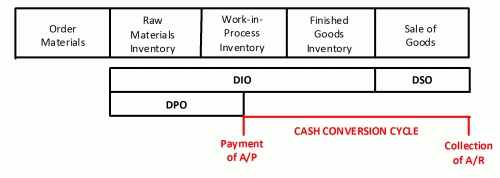Short-Term Approach to Working Capital Management
Working capital is the amount of capital that is readily available to an organization. Working capital is the difference between cash resources or assets readily convertible into cash (current assets) and cash obligations (current liabilities). As a result, the decisions relating to working capital are almost always current, i.e., short term, decisions. In other words, working capital management differs from capital investment decisions - specifically in terms of discounting and profitability. Working capital management applies different criteria in decision making. The main considerations are cash flow / liquidity and profitability / returns on capital. The most widely used measure of cash flow is the net operating cycle or cash conversion cycle. This measures how long a firm will be deprived of cash if it increases its investment in resources in order to expand customer sales.
The cash conversion cycle indicates the firm's ability to convert its resources into cash and informs management of the liquidity risk entailed by growth . Because this number effectively corresponds to the time that the firm's cash is tied up in operations and unavailable for other activities, management generally aims at shortening the cash conversion cycle as much as possible. However, shortening the cycle creates its own risks. While a firm could even achieve a negative cash conversion by collecting from customers before paying suppliers, a policy of strict collections and lax payments is not typically sustainable. The aim of the study and calculation of the cash conversion cycle is to change the policies relating to credit purchase and credit sales. A firm can change its standards for payment on credit purchases and getting payment from debtors on the basis of cash conversion cycle. If the firm is in an effective cash liquidity position, it can maintain its past credit policies.

Cash Conversion Cycle
Above is a chart showing a sample cash conversion cycle.